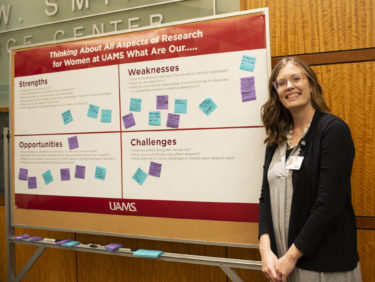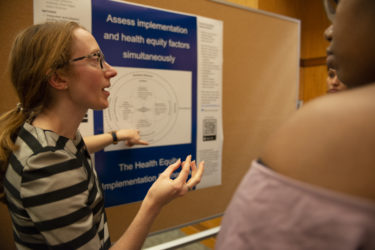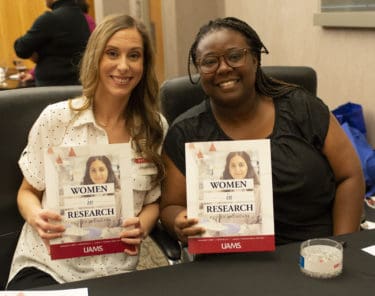The Women’s Faculty Development Caucus celebrated 30 years by turning a spotlight on women in research at UAMS, while also setting new goals to ensure that progress continues.
The Women in Research Poster Showcase was held Nov. 7 in the Fred W. Smith Conference Center on the 12th floor of the Jackson T. Stephens Spine & Neurosciences Institute. All women researchers on campus were invited to present posters. The presenters went in groups, allowing participants to visit other posters and network.
The format enabled visitors to see that women are advancing research in all aspects of health care and in all colleges and departments on campus.

“I am really impressed by the wide range of projects that I see around the room,” said Mari K. Davidson, Ph.D., an associate professor in the Department of Biochemistry and Molecular Biology in the College of Medicine. “I just talked to one person about safe sleep for babies, another about Stop the Bleed. We can get caught in a place where we just stick to our own area, so it’s really fun to see what’s going on.”
The Women’s Caucus was founded in 1989 at UAMS as a professional development and mentoring program to help women advance their careers and assume leadership positions. Its professional development efforts have resulted in an expanding organization that addresses the needs of all UAMS faculty members and trainees. The caucus provides leadership training, mentoring/advising, faculty handbook publications, faculty development, and networking opportunities.

The caucus is structured around faculty-led committees with rotating leadership, which simultaneously gives women leadership opportunities and provides new ideas and energy behind caucus activities.
Research Committee Chair Taren Swindle, Ph.D., assistant professor in the Department of Family and Preventive Medicine Research and Evaluation Division, welcomed the crowd with information on caucus history and inspiration for its future.
“For women in science, we have made some progress,” Swindle said. “The National Institutes of Health, for example, just announced last week they are extending early career status for career development applications after childbirth. Another example is here at UAMS, promotion and tenure guidelines have been changed to accommodate familial needs for men and for women. These are wonderful areas of progress, but we still have work to do.”
Swindle shared statistics that paint a picture of the remaining gender gaps:
- Only 32% of scientists in North America are women, according to a UNESCO report.
- While there is no difference in productivity between young male and female scientists, the first grant given to female scientists is $40,000 less on average, and that gap increases to almost double at Big 10 universities, according to a report published in JAMA.
- Women scientists are 20% less likely than men to come back to work after starting a family, according to an article in Nature.
- Only 21% of full professors are women, according to the American Medical Association.

Swindle pointed to a poster near the entrance which provided attendees an opportunity to list strengths, weaknesses, opportunities and challenges facing women faculty at UAMS. The committee supplied a few bullet points in each category, and the participants were encouraged to use sticky notes to provide their own insights.
“We’re really seeking your perspective on this,” Swindle said. “The Women’s Faculty Development Caucus has decided to broaden the research committee. In the past, the committee has focused on promoting students. These statistics and others show us that not only do students and young researchers need help, mid-career faculty face challenges too. There is a gap to bridge between young, promising researchers and full tenured professors, so we’re looking at how we can address that issue. This will also result in serving the faculty more broadly and better promoting all women in science.”
Eva Woodward, Ph.D., an assistant professor in the Department of Psychiatry in the College of Medicine, was swarmed by interest in her recent publication about ways to address health inequity using the tools of implementation science. Between interested visitors, she paused to say that the points made by Swindle were exactly why she welcomed the opportunity to take part in the research showcase.
“While men and women start out even at the assistant professor level, by the time you’re talking about full professor, the women fall out and the men dominate those positions, and we still have huge disparities to address,” Woodward said. “I’m taking time out of my schedule for this because it’s one way in which I can provide witness to the work of other women scientists who aren’t necessarily underrepresented in their field, but are underrepresented in positions of leadership, and also to be seen as well. It seems simple, but it’s important.”

